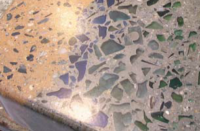The concrete industry at large designs mixes using the volumetric method. Fresh concrete is sold by volume, generally by the cubic yard, which is how we will look at it. Divide cubic yard volumes by 27 to get cubic foot volumes.
How much does a cubic yard weigh? How much does a 4-foot by 8-foot slab 1.5 inches thick need in volume? How do you weigh the ingredients that make up that volume? You need to be able to convert volume to weight and back again. It’s easy.
All materials have a specific gravity. The specific gravity of water is 1. All other materials’ specific gravity is some multiple heavier or lighter than water. Cement has a specific gravity of 3.15, so a given volume of cement is 3.15 times as heavy as the same volume of water. Some materials, such as water (1) and portland cement (3.15), always have the same specific gravity. Sand and stone vary, and the quarry measures this. Sand generally has a specific gravity of 2.60 to 2.75, stone 2.65 (pea gravel) to 2.80 (hard limestone).
A cubic foot of water weighs 62.4 pounds. A cubic foot of cement is 3.15 time as heavy, 196.65 pounds.
You need to do this math for the sand, stone and water in your mix. The key is playing with the numbers until you get the ingredients to add up to 27 cubic feet to make one yard of concrete. From there, simple division gets you the volumes required. In the end you will be able to calculate the volume you need and batch it precisely.
















